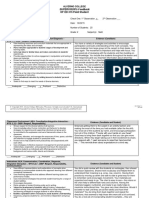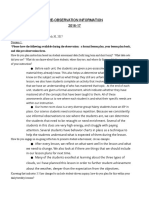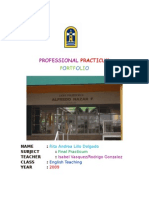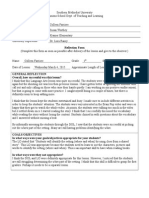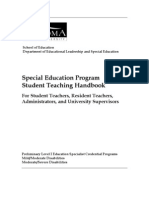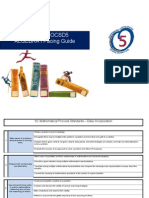Observation Field Notes Form
Observation Field Notes Form
Uploaded by
api-252392763Copyright:
Available Formats
Observation Field Notes Form
Observation Field Notes Form
Uploaded by
api-252392763Original Title
Copyright
Available Formats
Share this document
Did you find this document useful?
Is this content inappropriate?
Copyright:
Available Formats
Observation Field Notes Form
Observation Field Notes Form
Uploaded by
api-252392763Copyright:
Available Formats
EDUC 450
SCHOOL OF EDUCATION
CLAFLIN UNIVERSITY
OBSERVATION FIELD NOTES FORM DAY ONE
Candidate: ________O. Simone Rascoe___
Cooperating Teacher:___Ms. S.
Foster_____________________
Date: __8/31/15____ Content Area: __Math____ Lesson Topic: ______Matrices and
Exponents_________
DOMAIN 2: INSTRUCTION
APS 4: ESTABLISHING AND MAINTAINING HIGH EXPECTATION FOR LEARNERS
An effective teacher establishes, clearly communicates and maintains appropriate expectations for
student learning, participation and responsibility.
A. What did the teacher expect the students to learn from the lesson? How did the teacher convey
the purpose and relevance of the lesson to the students? In what ways did the students
demonstrate that they understood what the teacher expected for them to learn?
The teacher expected the students to learn how to solve matrices and find the determinants using the
graphing calculator. She also expected her Algebra I class to be able to determine what law of exponents
to use when given a problem and be able to simplify expressions with ease. The teacher conveyed the
purpose and relevance of the lesson to the students by writing the agenda on the agenda board in the
classroom. The students demonstrated that they understood what the teacher expected to learn by
completing the independent practice.
B.
What did the teacher expect the students to do during and after the lesson? How did the teacher
convey expectations for student participation and for accomplishing related assignments and
tasks? In what ways did the students demonstrate that they understood what the teacher expected
them to do?
The teacher expected the students to participate and do their assigned problems during the lesson. She
also expected the students to complete a worksheet during the 90 min block. She conveyed these
expectations by telling the students and trying to keep them on task. She also conveyed this expectation
by telling the students that each assignment will be graded. The homework that was given expected to be
completed for tomorrow; however, the school does not allow the homework to be taken for a grade. This
makes the students not work as hard on homework. Only three students completed their homework for
the class.
C.
How did the teacher help the students take ownership of the learning (e.g., by making the learning
relevant to the students, using scaffolding, providing opportunities for students to engage in selfassessment and reflection, teaching compensatory strategies when necessary)?
The teacher helped the students take ownership of the learning by making them accountable for the
assignment. She also did this by having their students find their own mistakes when practicing their
problems.
EDUC 450
SCHOOL OF EDUCATION
CLAFLIN UNIVERSITY
OBSERVATION FIELD NOTES FORM DAY TWO
Candidate: ________O. Simone Rascoe___
Cooperating Teacher:___Ms. S.
Foster_____________________
Date: __9/1/15____ Content Area: __Math____ Lesson Topic: ______Matrices and
Exponents_________
APS 5: USING INSTRUCTIONAL STRATEGIES TO FACILITATE LEARNING
An effective teacher promotes student learning through the effective use of appropriate instructional
strategies.
A. What was the content of the lesson?
The content of the lesson was learning about matrices and learning the law of exponents.
B. What instructional strategies did the teacher use during the lesson?
The teacher did a Do Now activity. The Do Now was solving a problem. The teacher
also led the class in an interactive lesson on the smart board. Another instructional
strategy the teacher used was requiring the students to create a foldable in the class
containing the law of exponents.
C.
In what ways did the teacher vary the instructional strategies during the lesson, and why?
The teacher varied instructional strategies by using the smart board sometimes and using the white
board other times. She also allowed the students to get out their own white boards and answer the
given problems on their dry erase boards. This was a great strategy because she gave the students
time to answer the problems on their own and then show her their answers by holding up the
board. This was great because it required everyone to participate and stay engaged in the lesson.
D.
What evidence suggests that the instructional strategies were or were not- effective in terms of
promoting student learning and success?
There was some evidence that the instructional strategies were not effective when some students
would lay their head down and sleep; however, by using the whole boards, the students stayed
awake and participated.
EDUC 450
SCHOOL OF EDUCATION
CLAFLIN UNIVERSITY
OBSERVATION FIELD NOTES FORM DAY THREE
Candidate: ________O. Simone Rascoe___
Cooperating Teacher:___Ms. S.
Foster_____________________
Date: __9/2/15____ Content Area: __Math____ Lesson Topic: ______Matrices and
Exponents_________
APS 6: PROVIDING CONTENT FOR LEARNERS
An effective teacher possesses a thorough knowledge and understanding of the discipline so that he or
she is able to provide the appropriate content for the learner.
A.
What evidence suggests that the teacher did-or did not- have a thorough knowledge and
understanding of the content? If content errors were made, did the teacher recognize and correct
them?
There really wasnt any evidence that the teacher did or did not have thorough knowledge and
understanding of the content. Any errors that the teacher made were simple ones such as calling
exponents variables and vice versa.
B.
What was the content of the lesson, and how did the content relate to the learners and their
learning?
The lesson was a group project by creating a booklet containing problems dealing with the laws of
exponents. This related to the learners and their learning by creating a hands-on activity where they could
test their knowledge. It also created a sense of accountability because of the group project aspect. The
students received one grade, so they had to make sure that everybody did their part.
C.
How did the teacher organize and present the content in order to make it clear and meaningful to
the students and to promote higher levels of knowledge, skills and/or cognitive processing?
The teacher present content to make things clear by lead them through a group project. This allowed time
for one on one interaction and group work. Students began to help one another and the teacher was able
to go around and help those that were struggling. This made the lesson meaningful because the students
had no choice by to complete their eight problems for the Law of Exponent book. If they didnt complete
it, they would let their group down.
EDUC 450
SCHOOL OF EDUCATION
CLAFLIN UNIVERSITY
OBSERVATION FIELD NOTES FORM DAY FOUR
Candidate: ________O. Simone Rascoe___
Cooperating Teacher:___Ms. S.
Foster_____________________
Date: __9/3/15____ Content Area: __Math____ Lesson Topic: _____Polynomials and
Exponents_________
APS 7: MONITORING, ASSESSING AND ENHANCING LEARNING
An effective teacher maintains a constant awareness of student performance throughout the lesson in
order to guide instruction and provide appropriate feedback.
A. What was the content of the lesson?
The content of the lesson was Adding and Subtracting Polynomials and Laws of Exponents.
B.
How did the teacher monitor student engagement, understanding and performance during the
lesson?
The teacher did a Do Now at the beginning of class. She also did guided practice with example problems
and independent practice after.
C.
What adjustments, if any, did the teacher make during the lesson, and why?
She made an adjustment in the class by re-teaching once she realized the students were getting
somewhat confused. She also created a worksheet that helped them determine what law of
exponent to use, when to use it, and what operation to use.
D.
What types of instructional feedback did the teacher provide to the students, and how effective
was the feedback in terms of enhancing student learning?
The instructional feedback that the teacher provided was during the guided practice. She encouraged the
students to think before answering and went over multiple problems with the students until they felt
comfortable doing their own independent practice.
EDUC 450
SCHOOL OF EDUCATION
CLAFLIN UNIVERSITY
OBSERVATION FIELD NOTES FORM DAY FIVE
Candidate: ________O. Simone Rascoe___
Cooperating Teacher:___Ms. S.
Foster_____________________
Date: __9/4/15____ Content Area: __Math____ Lesson Topic: ______Polynomials and
Exponents_________
DOMAIN 3: ENVIRONMENT
APS 8: MAINTAINING AN ENVIRONMENT THAT PROMOTES LEARNING
An effective teacher creates and maintains a classroom environment that encourages and supports
student learning.
A. What was the content of the lesson?
The content of the lesson was Adding and Subtracting Polynomials and Laws of Exponents.
B. Describe the physical environment of the classroom.
The physical environment of the classroom is always very clean. The teacher does not have desks for the
students. She has seven tables that seat four students each. The room is very spacious and organized.
C. What type of affective climate did the teacher create for the students?
The affective climate that the teacher creates for her students is a positive one. She encourages them to
participate everyday. She also is positive with her students even when they get problems wrong. There is
also a very affective environment because the teacher cares about how well the students are progress in
the class.
D.
In what ways did the teacher establish a culture of learning in the classroom (e.g., by facilitating
inquisitiveness, motivating to learn, cooperation, teamwork)?
The teacher establishes a culture of learning in the classroom in many ways. To name a few, she involves
the student at al times, she makes them work together in groups for a graded assignment, and she makes
them think about a problem before they speak. She motivates them to do their work as well.
APS 9: MANAGING THE CLASSROOM
An effective teacher maximizes instructional time by efficiently managing student behavior, instructional
routines and materials and essential non-instructional tasks.
A. What were the teachers expectations for student behavior? In what ways did the students
demonstrate that they understood the ways in which they were expected to behave? How did the
teacher address inappropriate student behaviors, if any, during the lesson?
The teacher expects the student to not talk while shes talking and to respect others in the classroom. The
students demonstrate this by staying on task. If they get off tasks, they listen to the teacher when she
gives them warnings. Inappropriate behaviors from students are dealt with by given warnings and
eventually a call home to their parents.
B. In what ways did the teacher maximize-or fail to maximize- instructional time?
The teacher maximizes the instructional time by over planning. The students always have work that needs
to be done; therefore, they have no excuse when they are talking.
C.
How did the teacher manage non-instructional routines and transitions between activities and/or
classes?
The teacher plans the lessons to where the transitions between activities and subjects are very smooth.
The students build off of each subject of math theyve learned previously.
You might also like
- Collins - Concise Revision Course For CSEC English ADocument252 pagesCollins - Concise Revision Course For CSEC English AKamara93% (15)
- Instructional Project 3Document5 pagesInstructional Project 3api-290533089100% (1)
- PostobservationreflectionDocument2 pagesPostobservationreflectionapi-355271701No ratings yet
- Teacher Duties and ResponsibilitiesDocument2 pagesTeacher Duties and ResponsibilitiesarvindranganathanNo ratings yet
- Student Teaching Evaluation EssayDocument2 pagesStudent Teaching Evaluation Essayapi-457369522No ratings yet
- Va Teacher Standards Look Fors CombinedDocument28 pagesVa Teacher Standards Look Fors CombinedMary McDonnell100% (1)
- MEMO For EDAHOD5-1 PDFDocument17 pagesMEMO For EDAHOD5-1 PDFNqobile Penelope Lafuleni100% (1)
- Recommendation CustodianDocument1 pageRecommendation CustodianAlex CorporalNo ratings yet
- Standard 5 Artifact ReflectionDocument3 pagesStandard 5 Artifact Reflectionapi-238727715No ratings yet
- Unit 2 Chapter 4 Evaluation of HRD Programs: Ms. Neha KalraDocument13 pagesUnit 2 Chapter 4 Evaluation of HRD Programs: Ms. Neha KalraNeha KalraNo ratings yet
- Classroom Observation FormDocument25 pagesClassroom Observation FormchingNo ratings yet
- Rubrics Rpms Gab-2016Document3 pagesRubrics Rpms Gab-2016Gerard Andres BalosbalosNo ratings yet
- Basic Kirkpatrick Structure at A GlanceDocument4 pagesBasic Kirkpatrick Structure at A GlanceGayatri GuhanNo ratings yet
- Pre Observation FormDocument2 pagesPre Observation Formapi-340141530100% (2)
- Bed 150 Observation List PrimaryDocument12 pagesBed 150 Observation List Primaryapi-330260924No ratings yet
- Interns Lesson Observation Resource I-Lor 1Document13 pagesInterns Lesson Observation Resource I-Lor 1api-703253998No ratings yet
- 201 - Observed Lesson FeedbackDocument4 pages201 - Observed Lesson Feedbackapi-334958359No ratings yet
- Alumni SolicitationDocument4 pagesAlumni Solicitationmarilou flojemonNo ratings yet
- PLC Reflections PDDocument3 pagesPLC Reflections PDapi-299178329No ratings yet
- Action Research ProposalDocument8 pagesAction Research ProposalJade JuanilloNo ratings yet
- Classroom Observation AssignmentDocument3 pagesClassroom Observation Assignmentapi-322892519No ratings yet
- Differentiated Lesson Plan (With Hypothetical Scenario)Document2 pagesDifferentiated Lesson Plan (With Hypothetical Scenario)api-242219136No ratings yet
- Report of Classroom ObservationDocument5 pagesReport of Classroom ObservationkirubahNo ratings yet
- Portfolio 5Document9 pagesPortfolio 5Eiram DheeNo ratings yet
- Observation 1 Professor FeedbackDocument3 pagesObservation 1 Professor Feedbackapi-305785129No ratings yet
- Observation 3Document3 pagesObservation 3api-350245383No ratings yet
- Observation Assignment For 4th GradeDocument11 pagesObservation Assignment For 4th Gradeapi-311761572No ratings yet
- Field Study Practice Teaching Revised 2019 Final Revision As of Nov. 13 2018Document21 pagesField Study Practice Teaching Revised 2019 Final Revision As of Nov. 13 2018HoneypatNo ratings yet
- Observation 5 ScienceDocument6 pagesObservation 5 Scienceapi-346507216No ratings yet
- ObservationDocument13 pagesObservationapi-213444883No ratings yet
- Sped Observation Notes For Ashley OneDocument5 pagesSped Observation Notes For Ashley Oneapi-282019703No ratings yet
- Region VII Division of Southern Leyte District of Macrohon: Ju N Ju L Au G Se PT Oc T No V de C Ja N Fe B Ma R Tot AlDocument3 pagesRegion VII Division of Southern Leyte District of Macrohon: Ju N Ju L Au G Se PT Oc T No V de C Ja N Fe B Ma R Tot AlBenedicto MindajaoNo ratings yet
- PostobservationreflectionDocument2 pagesPostobservationreflectionapi-285415524No ratings yet
- PLC ReflectionDocument5 pagesPLC Reflectionapi-357042891No ratings yet
- Learning Episode 1.Document3 pagesLearning Episode 1.Anny May GusiNo ratings yet
- Classroom Observation Assignment-Form 1 RgunduzDocument4 pagesClassroom Observation Assignment-Form 1 Rgunduzapi-361396333No ratings yet
- Responsibilities in Classroom Observation and Demonstration TeachingDocument11 pagesResponsibilities in Classroom Observation and Demonstration TeachingAira GuerreroNo ratings yet
- Gleason Teaching PhilosophyDocument2 pagesGleason Teaching Philosophyapi-295151906No ratings yet
- Reflective Journal EntryDocument2 pagesReflective Journal Entryapi-353136391No ratings yet
- PPST-RPMS BasedDocument33 pagesPPST-RPMS BasedJoselito Requirme AguaNo ratings yet
- Teacher As Reseacher 2Document7 pagesTeacher As Reseacher 2Ummu SalmahNo ratings yet
- Signal Similarity and DifferenceDocument2 pagesSignal Similarity and DifferenceReychel NecorNo ratings yet
- Professional Practise PortfolioDocument28 pagesProfessional Practise PortfolioandreitaangelitoNo ratings yet
- Template For Peer Observation 4 Yasmin IbrahimDocument4 pagesTemplate For Peer Observation 4 Yasmin Ibrahimapi-286718309No ratings yet
- Sim in English 4Document31 pagesSim in English 4twinkleannieNo ratings yet
- My Classroom ObservationDocument9 pagesMy Classroom ObservationFaiza AmadNo ratings yet
- RPMS Tool For Master Teachers I-IV (Highly Proficient Teachers) in The Time of COVID-19 S.Y. 2020-2021Document19 pagesRPMS Tool For Master Teachers I-IV (Highly Proficient Teachers) in The Time of COVID-19 S.Y. 2020-2021AMADO JR BANAWANo ratings yet
- Week Three Reflection What Were Some Positive Aspects?Document2 pagesWeek Three Reflection What Were Some Positive Aspects?lucs123No ratings yet
- Final Action Research ProposalDocument13 pagesFinal Action Research Proposalapi-621535429No ratings yet
- Self Assessment Peer Review and Video LinkDocument8 pagesSelf Assessment Peer Review and Video Linkapi-296854004No ratings yet
- Assignment No. 2 - Professional Development Plans - Template - Module 2 Assignment - GURO21Document4 pagesAssignment No. 2 - Professional Development Plans - Template - Module 2 Assignment - GURO21ARNOLD TEODORONo ratings yet
- Educ 2100 Classroom Observation FormDocument4 pagesEduc 2100 Classroom Observation Formapi-241394219100% (1)
- lp3 Reflection1Document3 pageslp3 Reflection1api-272774983No ratings yet
- Professional DevelopmentDocument4 pagesProfessional DevelopmentAh B KhyNo ratings yet
- Lesson Plan ReflectionDocument3 pagesLesson Plan Reflectionapi-550782205No ratings yet
- The 5es Instructional ModelDocument9 pagesThe 5es Instructional ModelRoselle BushNo ratings yet
- Exemplary Teacher Observation Reflection Form Used by Endorsement Candidates 1Document2 pagesExemplary Teacher Observation Reflection Form Used by Endorsement Candidates 1api-371115008No ratings yet
- Sped Student-Teacher HandbooksDocument33 pagesSped Student-Teacher HandbooksFrancis A. BuenaventuraNo ratings yet
- 21st Century Classroom Facilitating SkillsDocument2 pages21st Century Classroom Facilitating SkillsMayflor Guiyab100% (2)
- Teacher Beliefs StatementDocument1 pageTeacher Beliefs StatementAlanaNo ratings yet
- PerimeterDocument3 pagesPerimeterapi-216728214100% (1)
- The Philosophy of Teaching: The Teacher, The Pupil, The SchoolFrom EverandThe Philosophy of Teaching: The Teacher, The Pupil, The SchoolNo ratings yet
- Aps 7 PrintoutDocument1 pageAps 7 Printoutapi-252392763No ratings yet
- Aps 8 WeeblyDocument4 pagesAps 8 Weeblyapi-252392763No ratings yet
- Algebra I Pacing Guides 2015-2016 1Document9 pagesAlgebra I Pacing Guides 2015-2016 1api-252392763No ratings yet
- Aps 4 WeeblyDocument3 pagesAps 4 Weeblyapi-252392763No ratings yet
- Otejri Rascoe - ResumeDocument2 pagesOtejri Rascoe - Resumeapi-252392763No ratings yet
- Lesson Plan 2Document2 pagesLesson Plan 2Bawar KazmNo ratings yet
- Lecture 2Document18 pagesLecture 2AruzhanNo ratings yet
- Opposite Adjectives Vocabulary Esl Crossword Puzzle Worksheets For KidsDocument4 pagesOpposite Adjectives Vocabulary Esl Crossword Puzzle Worksheets For KidsJulia BlakeneyNo ratings yet
- 20-CP-86, 93, 44 ML ReportDocument14 pages20-CP-86, 93, 44 ML ReportMaria AftabNo ratings yet
- ME ToolAppraisal FormDocument5 pagesME ToolAppraisal FormJennifer SayongNo ratings yet
- Eaton High Lesson 4Document7 pagesEaton High Lesson 4api-396924469No ratings yet
- ARROYO - My Self Through The YearsDocument5 pagesARROYO - My Self Through The YearsDeeniece Myra ArroyoNo ratings yet
- Scientific TextDocument7 pagesScientific TextvivekNo ratings yet
- Coletti PDFDocument25 pagesColetti PDFArzalsyah SyarifNo ratings yet
- ToK Essay RubricDocument2 pagesToK Essay RubricAshita NaikNo ratings yet
- The Bilingual Project 2015Document19 pagesThe Bilingual Project 2015Mayra CetaresNo ratings yet
- UNIT-3 UIUXDocument2 pagesUNIT-3 UIUXkeerthishreey162004No ratings yet
- Analisis Logical PositivismDocument2 pagesAnalisis Logical PositivismdonyNo ratings yet
- Scott C. Lunn: CitizenshipDocument2 pagesScott C. Lunn: Citizenshipapi-241706205No ratings yet
- Problems and Prospects of Implementing Knowledge Management in University Libraries: A Case Study of Banaras Hindu University Library SystemDocument9 pagesProblems and Prospects of Implementing Knowledge Management in University Libraries: A Case Study of Banaras Hindu University Library Systemtilahun yeshiyeNo ratings yet
- Inquiry 5e Lesson Plan BetaylorDocument5 pagesInquiry 5e Lesson Plan Betaylorapi-488919756100% (1)
- Present Continuous What Are They Doing On Saturday Grammar Drills Oneonone Activities - 139314Document2 pagesPresent Continuous What Are They Doing On Saturday Grammar Drills Oneonone Activities - 139314Hsu Lai WadeeNo ratings yet
- Mowrer's Two Factor Theory (Read)Document6 pagesMowrer's Two Factor Theory (Read)PratikaNo ratings yet
- Edu 101Document2 pagesEdu 101maheenshahid011No ratings yet
- Imparfait Passe Simple Passe Compose Plus Que ParfaitDocument5 pagesImparfait Passe Simple Passe Compose Plus Que Parfaitkaraouilaid100% (1)
- Personality and Consumer BehaviorDocument40 pagesPersonality and Consumer BehaviorAnant JainNo ratings yet
- Causative VerbsDocument6 pagesCausative Verbsajit_ceoNo ratings yet
- Oet SpeakingDocument23 pagesOet Speakingacd241100% (2)
- Apprisal CommentsDocument2 pagesApprisal CommentsUTKARSH GALANDENo ratings yet
- Speaker Purpose and Other Human FactorsDocument3 pagesSpeaker Purpose and Other Human FactorsFatin KhairNo ratings yet
- CRIM 4 - Professional Conduct and Ethical StandardsDocument27 pagesCRIM 4 - Professional Conduct and Ethical StandardsMar YanNo ratings yet
- B8 3term English WK 7Document5 pagesB8 3term English WK 7Wynifred AboagyeNo ratings yet
- The 7es Model of Science TeachingDocument25 pagesThe 7es Model of Science TeachingAlfie AndoNo ratings yet
























